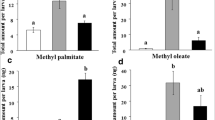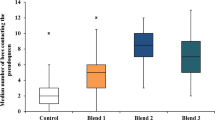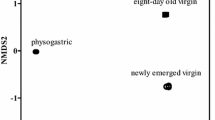Abstract
Capping of workerApis mellifera cells is elicited by four fatty acid methyl esters (Methyl palmitate, methyl oleate, methyl linoleate, and methyl linolenate) that are present on the surface of the worker and drone larvae only a few hours before the cell is closed. The amount of the pheromone reaches its maximum value when the cell has just been capped, at 8.5 and at 10.25 days of age, respectively, for worker and drone larvae. Thereafter, the amount of the pheromone decreases to its initial level. These data suggest that the esters also have a role in the capping of the drone cells, the temporal signal allowing the worker bees to recognize the age of the larvae and then to do the appropriate behavior. Two pheromonal components, methyl palmitate and methyl linolenate, and the inactive ethyl palmitate are kairomones attractive toVarroa females. Their secretion by the larvae follows the same pattern of development as the pheromonal signal. The longer and greater kairomonal signal in drone larvae, compared to worker secretion, could explain the preference ofVarroa towards drone brood.
Similar content being viewed by others
References
Arnold, G., 1990. Current and recent research onVarroa.Am. Bee. J. 130:257–261.
Boot, W.J., Calis, J.N.M., andBeetsma, J. 1991. Invasion of Varroa mites in honeybee brood cells: Observation ofVarroa mite behaviour, pp. 43–44,in W. Ritter (ed.). Proceedings of the International symposium on Recent Research on Bee Pathology. Apimondia, Bucharest.
Buchner, R., 1953. Beeinflussung der Grösse der Arbeitsbiene durch Raum-und Nahrungsmangel während der Larvenzeit.Arch. Entw.-mech. 146:544–579.
Camazine, S., 1986. Differential reproduction of the mite,Varroa jacobsoni (Mesostigmata: Varroidae), on Africanized and European honey bees (Hymenoptera: Apidae).Ann. Entomol. Soc. Am. 79:801–803.
De Ruijter, A., 1986. Preference ofVarroa jacobsoni Oudemans for different cell types and some factors affecting reproduction, pp. 165–167,in Proceedings of the XXXth International Apicultural Congress. Apimondia, Tokyo.
Dietz, A. 1972. The nutrition basis of caste determination in honeybees, pp. 271–279,in J.G. Rodriguez (ed.). Insect and Mite Nutrition. North Holland Publ., Amsterdam.
Free, J.B. 1987. Pheromones of Social Bees. Chapman and Hall, London.
Free, J.B., andWinder, M.E. 1983. Brood recognition by honeybee (Apis mellifera) workers.Anim. Behav. 31:539–545.
Fuchs, S. 1990. Preference for drone cells byVarroa jacobsoni Oud. in colonies ofApis mellifera carnica.Apidologie 21:193–199.
Fuchs, S., andMüller, K. 1988. Invasion of honeybrood cells byVarroa jacobsoni in relation to the age of the larvae, pp. 77–79,in R. Cavalloro (ed.). European Research on Varroatosis Control. Brookfield, Rotterdam.
Gontarski, H. 1954, Untersuchen über die Verwertung von Pollen und Heffe zur Brutpflege der Honigbiene.Z. Bienenforsch. 2:161–180.
Grobov, O.F. 1977. La varroase des abeilles, pp. 52–79,in La Varroase-maladie des Abeilles, Apimondia, Bukarest.
Haydak, M.H. 1970. Honey bee nutrition.Annu. Rev. Entomol. 15:143–156.
Ifantidis, M.D. 1988. Some aspects of the process ofVarroa jacobsoni mite intrance into honey bee (Apis mellifera) brood cells.Apidologie 19:387–396.
Issa, M.R.C., De Jong, D., andGonçalves, L.S. 1986. Study of the preference of the miteVarroa jacobsoni forApis mellifera drones, pp. 159–160, in Proceedings of the XXXth International Apicultural Congress. Apimondia, Tokyo.
Koeniger, N. 1978. Das Wärmen der Brut bei der Honigbiene.Apidologie 9:305–320.
Koeniger, N., andVeith, H.J. 1983. Glyceryl-1,2-dioleate-3-palmitate, a brood pheromone of the honey bee (Apis mellifera L.).Experientia 39:1051–1052.
Koeniger, N., andVeith, H.J. 1984. Spezifit′ eines Brutpheromons und Bruterkennung bei der Honigbiene (Apis mellifera).Apidologie 15:205–210.
Le Conte, Y. 1990. Contribution à l'étude des relations abeille-Varroa, Approche comportementale, chimique et génétique. Thesis. Université Paris XI, Orsay, France.
Le Conte, Y., Arnold, G., Trouiller, J., Masson, C., Chappe, B., andOurisson, G. 1989. Attraction of the parasitic miteVarroa to the drone larvae of honey bees by simple aliphatic esters.Science 245:638–639.
Le Conte, Y., Arnold, G., Trouiller, J., Masson, C., andChappe, B. 1990. Identification of a brood pheromone in honeybees.Naturwissenschaften 77:334–336.
Message, D., andGonçalves, L. 1983. Einfluss der Zelldimensionen auf der Befallsgrad mitVarroa jacobsoni, p. 276,in Proceedings of the XXIXth International Apicultural Congress. Apimondia, Budapest.
Otten, C., andFuchs, S. 1988. Individual differences inVarroa jacobsoni of preference for drone larvae to worker bee larvae, pp. 69–71, in R. Cavalloro (ed.). European Research on Varroatosis Control. Brookfield, Rotterdam.
Phelan, P.L., Smith, A.W., andNeedham, G.R. 1991. Mediation of host selection by cuticular hydrocarbons in the honeybee tracheal miteAcarapis woodi (Rennie).J. Chem. Ecol. 17:463–473.
Rembold, H., Lackner, B., andGeistbeck, I. 1974. The chemical basis of honeybee,Apis mellifera, caste formation partial purification of queen bee determinator from royal jelly.Insect Physiol. 20:307–314.
Ritter, W. 1981. Varroa disease of the honey beeApis mellifera.Bee World 62:141–153.
Rosenkranz, P., Tewarson, N.C., andEngels, W. 1984. Optimal host selection by reproductive femaleVarroa jacobsoni, p. 628, in W. Engels (ed.). Advances in Invertebrate Reproduction. Elsevier, Amsterdam.
Schulz, A.E. 1984. Reproduktion und Populationsentwicklung der Parasitischen MilbeVarroa jacobsoni Oud. in Abhängigkeit vom Brutzyklus ihres WirtesApis mellifera.Apidologie 15:401–420.
Sulimanovic, D., Ruttner, F., andPechhacker, H. 1982. Studies on the biology of reproduction inVarroa jacobsoni.Honeybee Sci. 3:109–112.
Tewarson, N.C. 1983. Fortplanzungsphysiologische Untersuchungen anVarroa jacobsoni: Eierblage udn Schüpfen der Erstlarve.Allg. Dtsch. Imken. 8:277–280.
Townsend, F.G., andShuel, R.W. 1962. Some recent advances in apicultural research.Annu. Rev. Entomol. 7:481–500.
Trouiller, J., Chappe, B., Arnold, G., Le Conte, Y., andMasson, C.1991. Temporal pheromonal and kairomonal secretion in the brood of honeybees.Naturwissenschaften 78:368–370.
Wieting, J. andFerenz, H.-J. 1991. Behavioral study on the invasion of honey bee brood by the miteVarroa jacobsoni on wax combs and ANP combs.Am. Bee J. 131:117–118.
Woyke, J. 1977. Cannibalism and brood rearing efficiency in honeybees.J. Apic. Res. 16:84–94.
Author information
Authors and Affiliations
Rights and permissions
About this article
Cite this article
Trouiller, J., Arnold, G., Chappe, B. et al. Semiochemical basis of infestation of honey bee brood byVarroa jacobsoni . J Chem Ecol 18, 2041–2053 (1992). https://doi.org/10.1007/BF00981926
Received:
Accepted:
Issue Date:
DOI: https://doi.org/10.1007/BF00981926




